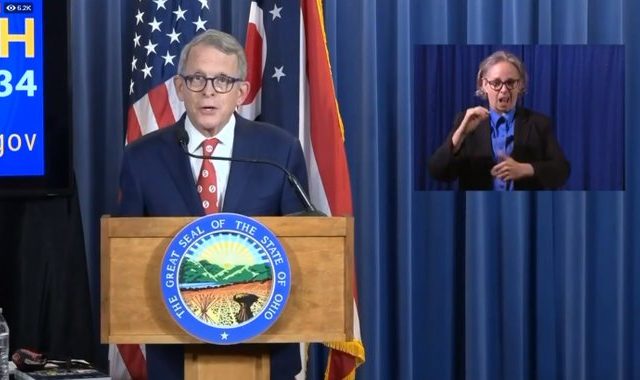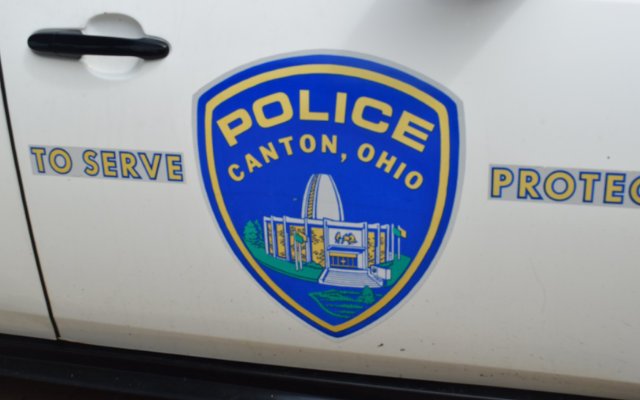State to Address COVID-19 at County Level

COLUMBUS (News Talk 1480 WHBC) – This afternoon Governor Mike DeWine spoke in Columbus, providing updates on COVID-19 in Ohio. Here is a complete outline on everything that was discussed.
Return Plan for Ohio Schools
This afternoon Governor DeWine announced the guidelines for K-12 schools to follow when developing their reopening plans. The Governor says schools can adjust their rules to what works best for them for a safe environment and that protects students/staff.
The plan is divided into five guidelines:
- Assessing for Symptoms: Schools should take temperatures of students and staff each day before entering the building. Those who are sick must be sent home. Each school is also responsible for developing its own testing strategy.
- Wash and Sanitize Hands: Schools must allow more time for students and staff to wash hands throughout the day. Additional hand sanitizing stations must be added to areas with high foot traffic.
- Thorough Cleaning: Additional cleaning must take place inside school facilities, before, during and after school hours.
- Social Distancing: Schools must do their best to keep six feet between students. This applies to the classroom, cafeteria, buses and any other area where students can come in contact with each other. DeWine says schools can do things such as modifying schedules to account for these adjustments.
- Implement Face Covering Policy: School staff is required to wear face coverings unless it is unsafe or doing so significantly interferes with the learning process. If face coverings are not practical, face shields should be considered. The state recommends all students 3rd grade and above wear face masks while at school.
Governor DeWine says he intends to work with the general assembly to develop a plan to provide schools with some financial assistance to help make COVID-19 related adjustments. The Governor mentioned that some money could come from the federal CARES Act fund.
More details on these guidelines will be available on the state’s coronavirus website. The guidelines were not posted during the time of the press conference due to technical issues.
New Phase: “How We Live with the Virus”
Governor DeWine announced this afternoon that the state will start to address COVID-19 related issues on a county by county basis. Ohio will have a color-coded system is built on data to assess COVID-19 spread and inform and empower individuals, businesses, & local government in their response.
DeWine says the system has four levels to provide Ohioans with guidance on the severity of the problem in the counties in which they live. The levels will be labeled by color and are determined by seven data indicators that identify the risk level for each county and a corresponding color code to represent that risk level.
The four levels are:
- Yellow: A county has triggered zero or one of the seven indicators, and there is active exposure and spread. DeWine says 53 Ohio counties are currently at Alert Level 1. The majority of these counties are seeing a moderate number of cases, according to the CDC’s definition.
- Orange: A county has triggered two or three of the seven indicators, and there is increased risk of exposure and spread. 28 Ohio counties in this category, including Stark County. These counties are seeing cases that are growing in the community in the last two weeks.
- Red: A county has triggered four or five of the seven indicators, and there is very high exposure and spread. There are currently 7 Ohio counties at Level 3. Risk is very high. DeWine says Ohioans should limit activities as much as possible and wear a mask when they go out.
- Purple: A county has triggered six to seven of the indicators, and there is severe exposure and spread. Stay home as much as possible. No counties are in purple right now.
Here is a look at the current Public Health Advisory System map. pic.twitter.com/wCj2JECSUl
— Governor Mike DeWine (@GovMikeDeWine) July 2, 2020
The seven data indicators include:
- New Cases Per Capita: When the data shows a county has had an average of 50 cases per 100,000 people over a 2-week period, that triggers a flag for an increasing case rate. The Governor says using this data means the state is taking into account population of a county when monitoring case increases.
- Sustained Increase in New Cases: If the number of new cases in a county continually increases, that’s another indicator of virus spread. A county will be flagged for meeting this indicator if the data show at least a five-day period of sustained new case growth.
- Proportion of Cases Not Congregate Cases: Data showing more than 50% of new cases originating from non-congregate settings during at least one of the past three weeks will trigger a flag on this indicator.
- Sustained Increase in Emergency Room Visits: ER data will show state health officials the trend in the number of people who visit an emergency department with COVID-19 symptoms or a COVID diagnosis as a result of the visit. A county is flagged when there is an increase in such ER visits over a five-day period.
- Sustained Increase in Outpatient Visits: This data set looks at the number of people visiting outpatient settings, including telehealth appointments, with suspected or confirmed COVID-19 symptoms. A county is flagged when there is an increase over a five-day period.
- Sustained Increase in New COVID-19 Hospital Admissions: When the numbers show at least a five-day period of sustained growth in the number of county residents with COVID-19 who are admitted to a hospital, the county will be flagged for meeting this indicator.
- Intensive Care Unity Bed Occupancy: This indicator looks at regional data for both COVID-19 and non-COVID use of ICU beds. A county is flagged for this indicator when the regional ICU occupancy goes above 80% for at least three of the last seven days.
The state is also working to refine additional measurements in order to drill down even further on risk-levels. Those additional measurements include: contact tracing, tests per capita, percent positivity.
Bars and Restaurants
As COVID-19 continues to spread and a busy holiday weekend approaches, Governor DeWine spoke directly to the state’s bars and restaurants, asking them to not forget about the virus and to keep following the guidelines.
Since May, when restaurants and bars reopened, the Ohio Department of Commerce has been working with local jurisdictions to extend liquor permits to outside spaces next to bars (parking lots/sidewalks) so seating capacity can expand outside to keep patrons distanced.
“We encourage owners to continue to work with us and their local governments to come up with creative ways to expand their outdoor seating capacity so that everyone can stay safe and be socially distanced,” said DeWine.
So far, over 300 expansion requests have been granted to allow patrons more opportunities to enjoy dinner or drinks while enjoying themselves in a safe environment.
“I ask our restaurant and bar owners to continue to insist on social distancing and other efforts to control the spread,” said DeWine. “This is absolutely vital.”



